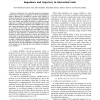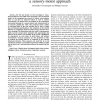122 search results - page 8 / 25 » Learning motor primitives for robotics |
ICRA
2010
IEEE
13 years 6 months ago
2010
IEEE
— Interaction of a robot with dynamic environments would require continuous adaptation of force and impedance, which is generally not available in current robot systems. In contr...
ICONIP
2007
13 years 9 months ago
2007
Policy learning which allows autonomous robots to adapt to novel situations has been a long standing vision of robotics, artificial intelligence, and cognitive sciences. However, ...
TSMC
2010
13 years 2 months ago
2010
Abstract--For the last decade, we have developed a visionbased architecture for mobile robot navigation. Our bio-inspired model of the navigation has proved to achieve sensory-moto...
CRV
2011
IEEE
12 years 7 months ago
2011
IEEE
—Motion information is an important cue for a robot to separate foreground moving objects from the static background world. Based on the observation that the motion of the backgr...
RAS
2008
13 years 7 months ago
2008
The task of trajectory design of autonomous vehicles is typically two-fold. First, it needs to take into account the intrinsic dynamics of the vehicle, which are sometimes termed ...


